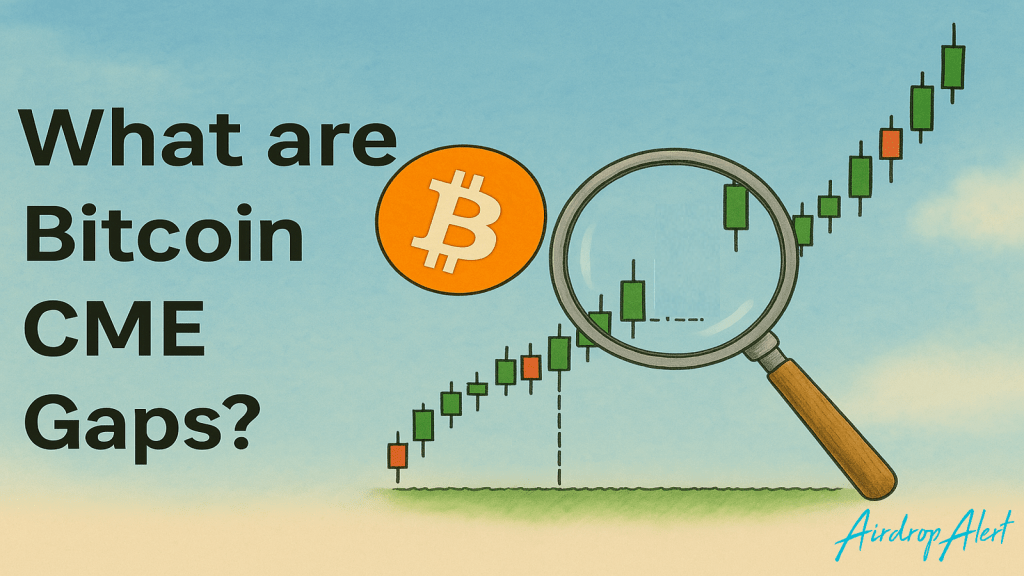Bitcoin CME gaps are a popular topic among crypto traders. These gaps, which appear on the Chicago Mercantile Exchange (CME) Bitcoin futures chart, provide insight into potential future price movements. They occur when Bitcoin’s price changes while the CME market is closed, creating gaps between the closing price on Friday and the opening price on Sunday evening. In this guide, we’ll break down what Bitcoin CME gaps are, why they happen, and how to use them in your trading strategy.
This is part 11 of a series of trading guides
What Are Bitcoin CME Gaps?
Bitcoin CME gaps are price differences that appear between the closing price of Bitcoin futures on Friday and the opening price on Sunday evening. Since the CME futures market operates from Sunday to Friday, a weekend break occurs between Friday and Sunday. During this time, Bitcoin’s price can change, leading to gaps in the CME futures chart.
There are two types of CME gaps:
- Gap Up: This happens when Bitcoin’s price opens higher than the previous CME closing price.
- Gap Down: This occurs when Bitcoin’s price opens lower than the previous CME closing price.
Why Do CME Gaps Matter?
Many traders focus on CME gaps because they believe Bitcoin tends to “fill” them. This means that the price often retraces to cover the gap area. Here’s why gaps are important:
- Market Efficiency: When the CME market reopens, liquidity is restored, and price corrections often occur to fill the gap.
- Trader Psychology: Traders are aware of these gaps, and their actions can lead to self-fulfilling price movements.
- Institutional Influence: The CME futures market attracts institutional investors, whose trades influence Bitcoin’s price action.

In the example above, you can see how Bitcoin just filled the CME gap from November 11th of 2024. But rest assured, there is a CME gap of February 24th waiting for us at $93,200.
How to Trade Bitcoin CME Gaps
Understanding CME gaps can help traders spot potential trading opportunities. Below are some common strategies for trading these gaps:
Check out the 6 best crypto exchanges of 2025
1. Gap-Fill Trading Strategy
The gap-fill strategy is based on the idea that Bitcoin often fills the CME gaps. Traders can use this trend for entry and exit points.
- Entry Point: Once you spot a gap, wait for confirmation that Bitcoin is moving toward filling it.
- Exit Point: Close your trade when the price reaches the gap’s endpoint.
2. Support and Resistance Confirmation
CME gaps can act as strong levels of support or resistance. You can use these gaps to identify potential bounce or breakout points.
- Support/Resistance Levels: Pay attention to where the gap occurs. It could indicate a key support or resistance level.
- Technical Indicators: Combine the gap with other indicators like moving averages, Fibonacci retracements, or the Relative Strength Index (RSI) to increase accuracy.
3. Breakout Trading Strategy
In some cases, Bitcoin may not fill the gap quickly. This could signal strong momentum in the opposite direction.
- Trade Continuation: If Bitcoin moves away from the gap with strong volume, consider trading the continuation.
- Risk Management: Use stop-loss orders to limit potential losses in case of sudden price reversals.
Read our previous guide on Shorting.
Risks Involved in Trading CME Gaps
While trading CME gaps can be profitable, it’s important to be aware of the risks involved:
Not All Gaps Fill: Some gaps remain unfilled for a long time, making them less predictable.
Volatility: Bitcoin’s price can be highly volatile, which could lead to sudden price movements.
Market Manipulation: Price spikes or drops can sometimes be misleading, trapping traders in unprofitable positions.

Conclusion
Bitcoin CME gaps are a powerful tool for traders looking to anticipate price movements. They provide potential entry and exit points, but it’s crucial to use proper risk management and technical analysis. By understanding how and why these gaps form, traders can make more informed decisions and potentially increase their chances of success.
FAQs
- Does Bitcoin trade on CME? Yes, Bitcoin futures trade on the Chicago Mercantile Exchange (CME) under the ticker BTC1!
- How can I see CME gaps on TradingView? On TradingView, search for “CME:BTC1!” and look for gaps between Friday’s close and Sunday’s open.
- What does CME stand for in crypto? CME stands for the Chicago Mercantile Exchange, a major derivatives exchange that offers Bitcoin and Ethereum futures trading.
- How do I find CME gaps in Bitcoin? Check the CME Bitcoin Futures (BTC1!) chart on TradingView, looking for gaps between the market’s close on Friday and open on Sunday.
- What is a gap indicator? A gap indicator highlights price gaps on charts where the opening price significantly differs from the previous close.
By keeping these strategies and tips in mind, you can take advantage of Bitcoin CME gaps and enhance your trading approach.
We write regular crypto trading content, on which we trade ourselves as well. Check out our trading section and join us.
Don’t forget to claim your bonus below and see you next time!



